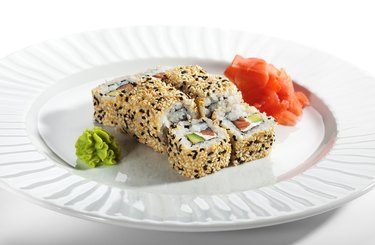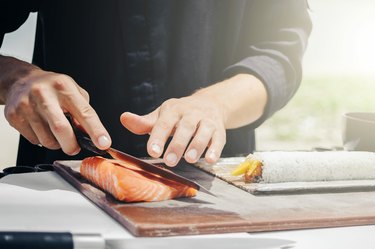
Sushi is a Japanese food made from rice, fish, seaweed and other ingredients. Different ingredients produce different rolls, such as the California roll and Alaskan roll. According to the Sushi Sama website, the Alaskan roll includes avocado, imitation crab meat, rice, salmon and nori, which is toasted seaweed. Although the exact nutritional information may vary due to the portions of ingredients used, Alaskan rolls tend to have similar calorie content even at different restaurants due to the fact that the same ingredients are always used.
Calories
Video of the Day
According to the nutrition information from MyFitnessPal, a typical serving of Alaskan rolls — 8.6 ounces — provides 304 to 450 calories. Because the average recommended daily calorie intake is 2,000 calories, consuming eight rolls would provide about 18 percent of your total daily calorie intake.
Video of the Day
Macronutrients
Because Alaskan rolls are covered in rice, they provide a large amount of carbohydrates. MyFitnessPal says that an eight-piece serving of Alaskan rolls contains 63 grams of carbohydrates, with no fiber or sugar. Because of the lack of fiber, Alaskan rolls may not be very filling — Everyday Health points out that fiber helps keep you feeling full, which can aid in weight management.

Because sushi contains fish, you might expect it to be high in protein. However, only small pieces of fish are contained in each roll. An eight-piece serving contains 22 grams of protein. Although Alaskan rolls do not have fiber to fill you up, Medical News Today notes that research indicates consumption of protein may blunt your appetite.
Although salmon is a fatty fish, Alaskan rolls do not contain large cuts of fish and therefore do not contain much fat. The nutrition information at MyFitnessPal explains that eight Alaskan rolls contain just 7 grams of fat, 1 gram of which is saturated fat.
Knowing the best and worst kinds of sushi to eat will help you make healthier choices when you're ordering. A good rule of thumb is to remember that spicy rolls are often made with high-fat mayonnaise and crunchy rolls are battered and fried.